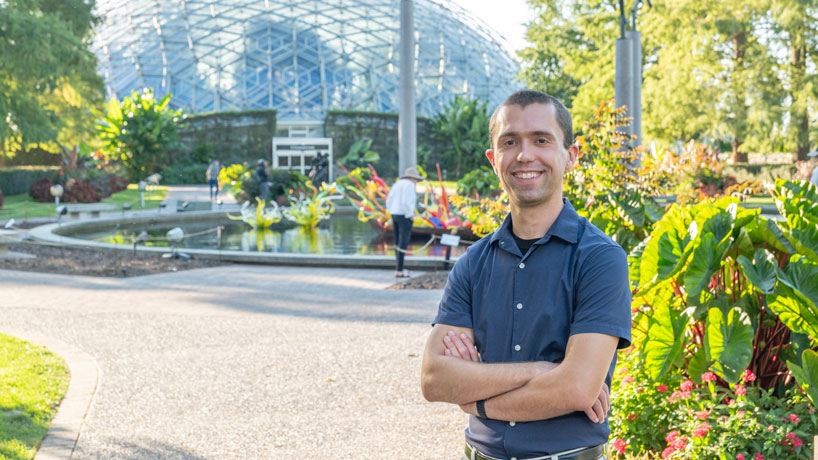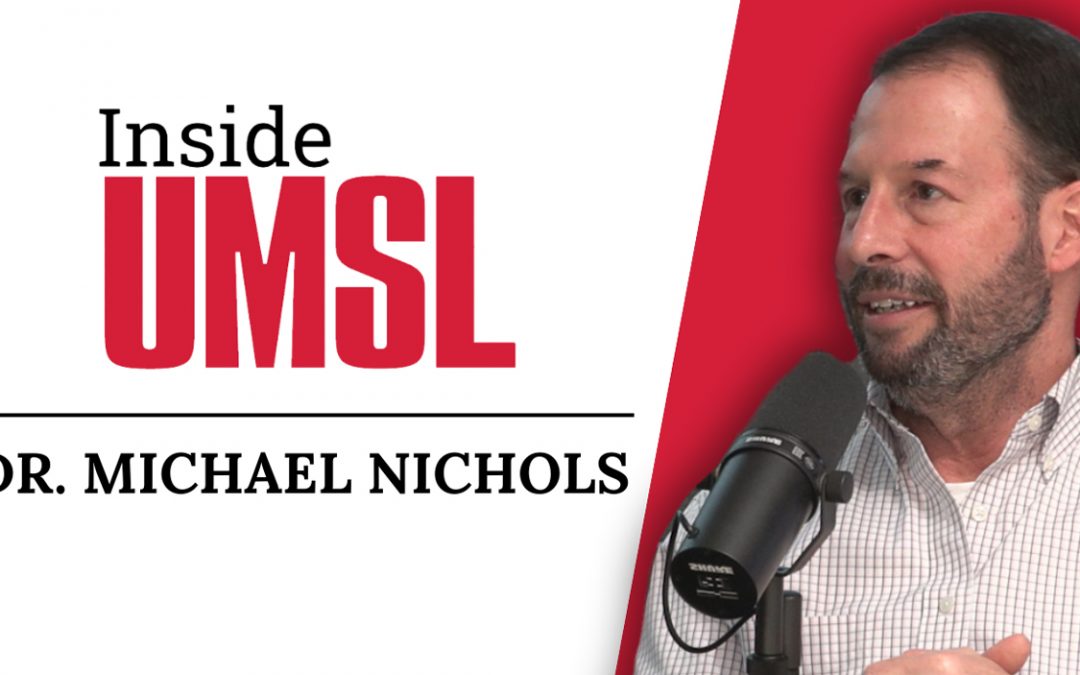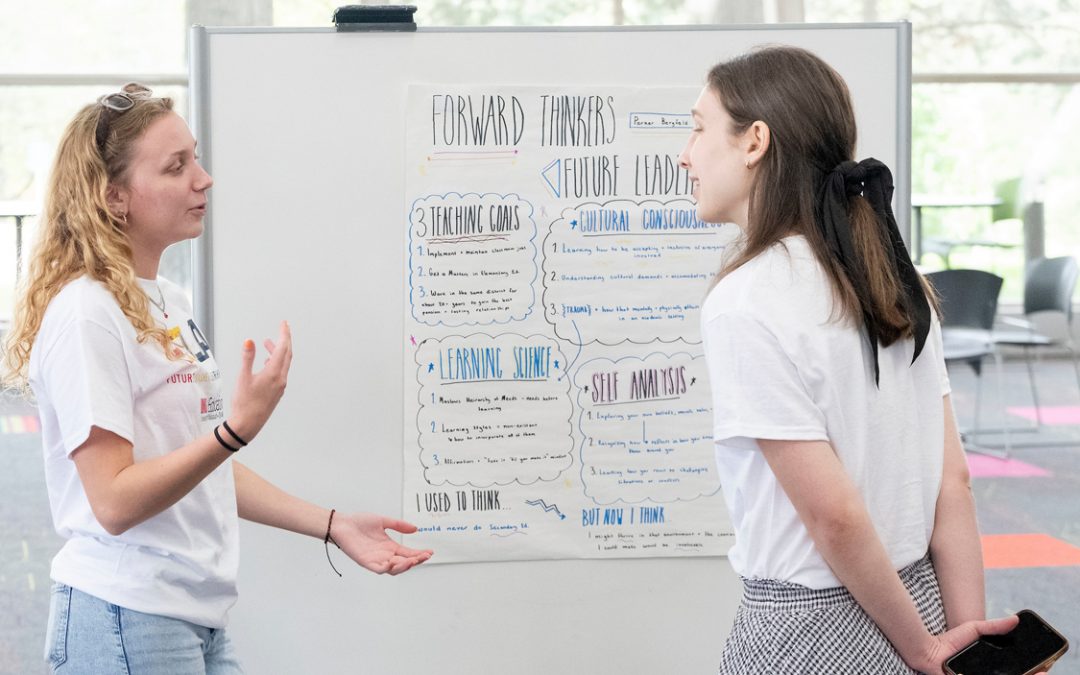
Matt Austin began his position as the curator of biodiversity data at the Missouri Botanical Garden in July. He earned his PhD in biology at UMSL in 2020. (Photo by Derik Holtmann)
Matt Austin made semi-regular visits to Missouri Botanical Garden as a child growing up in Kirkwood, Missouri.
He remembers strolling through the Japanese Garden with his family and following the winding path through the Climatron, admiring the tropical plants. Sometimes, they’d attend the Whitaker Music Festival on Wednesday evenings in the summer, listening to music at twilight amid the blooming flowers.
“I credit being exposed to the garden when I was young to showing me the diversity of plants around the world and how interesting plant biology is,” Austin said.
He never imagined he’d one day end up working there. But in July, Austin assumed a new position as curator of biodiversity data at the renowned center for botanical exploration as well as plant science and conservation research.
The PhD in biology Austin earned from the University of Missouri–St. Louis in 2020 started him on the path to his new career.
“Through the Whitney R. Harris World Ecology Center at UMSL, I became familiar with what scale of research the garden – and the Saint Louis Zoo – do across the world,” Austin said. “That led me to realizing just how big of an institution the garden is for botanical research.”
Austin at the time was studying bumblebees, specifically exploring how environmental changes happening around them are shaping their behavior in their critical role as pollinators.
It wasn’t a big leap to shift his focus to the other side of pollination and study flowering plants when he received a postdoctoral fellowship at the Living Earth Collaborative at Washington University in St. Louis.
“It was a good opportunity for me because it built on connections that I had formed with the biodiversity community in St. Louis throughout my PhD,” Austin said. “Those connections ultimately led me to continue on with my career in the permanent position that I’m in today.”
Austin’s postdoctoral research focused on how warming temperatures and changes in precipitation due to climate change have been impacting flowering times of plants in the Greater St. Louis region.
His new research lab at the Missouri Botanical Garden is continuing to build on that work, drawing on historical data, much of it collected at the garden’s Shaw Nature Reserve going back as far as the 1930s.
“We have a dataset that spans more than a century across dozens of species that contains flowering dates throughout the year for each of these species throughout time,” Austin said. “Each flowering record we have is coupled with temperature and precipitation data from when and where the plant was collected or observed. This allows us to study how climatic changes, specifically changes to temperature and precipitation, have affected the time of year that plants are flowering and, thus, the overlap of different species flowering periods. That opens up different questions about how changing flowering times are changing interactions between plants and their pollinators and other types of ecological interactions.”
He’s been intrigued by changes in the flowering patterns among autumn blooming species, including asters. He said about three quarters of the species he’s studied have increased the length of time they’re flowering compared to a century earlier. He’s observed plants both begin flowering earlier and end flowering later amid warmer temperatures.
The ramifications of longer flowering periods requires more study, but it has led to a greater number of species blooming at the same time, which can create greater competition between plants for pollinators and also could lead to pollen being transferred between species, potentially reducing fitness or resulting in hybridization among closely related species.
Austin has made extensive use of the garden’s herbarium in his research. It is one of the world’s premier research resources for specimens and information on bryophytes and vascular plants with more than 7 million species collected from around the world. The collection features species going back more than two centuries, including at least one specimen collected by Charles Darwin on his famous Voyage of the Beagle.
In addition to his research work, Austin’s role at the garden also has him leading efforts to digitize that herbarium’s collection. It’s an enormous undertaking given its range across the globe, throughout time and across species. But it has even greater implications for scientific discovery in the future.
“Biological collections have always been key for biologists to have access to historical data,” he said. “Digitizing biological collections, such as the herbarium, I truly think will revolutionize the field of biology because it’s essentially bringing big data to the ecological sciences.
“One of the cool things that we’re seeing with digitization of biological collections is application of new types of technology to them. For instance, we’re at a point in time where artificial intelligence is being applied to digitize collections in different ways.”
He’s interested in the potential to use machine learning models to automate trait extraction from pictures of herbarium specimens, allowing for an increase in the scale of data collection compared to traditional methods that require taking measurements by hand.
There are countless other advancements that might be made possible by technology, and Austin is eager to watch them develop.
“I think it really is an open question what the field will look like 10 years from now,” he said. “It’s a very exciting time to be in biology.”














